Blood splashes across the sand as thousands roar in unison. The ground trembles beneath the thundering hooves of four quadrigas racing neck-and-neck around the final turn. A massive warship erupts in flames while warriors clash on its deck, their fate sealed by the emperor’s thumbs. While we sit in silent isolation streaming the latest series, Romans participated in entertainment experiences so visceral and communal that our modern digital diversions seem utterly bloodless by comparison.
The contrast couldn’t be more striking. Our entertainment comes through screens, passively consumed in isolation. The Romans? They pioneered immersive, multisensory spectacles that engaged all senses simultaneously while strengthening social bonds. Their entertainment wasn’t just watched – it was experienced, with real stakes, real consequences, and genuine communal emotion that no algorithm can replicate.
The Romans understood something fundamental about human psychology that we’ve forgotten in our digital age: true entertainment requires more than just visual stimulation – it demands full sensory engagement, social connection, and the electric thrill of unpredictability. Their entertainment traditions weren’t mere diversions; they were cultural cornerstones that reflected and reinforced their values while providing experiences that could never be replicated through a screen.
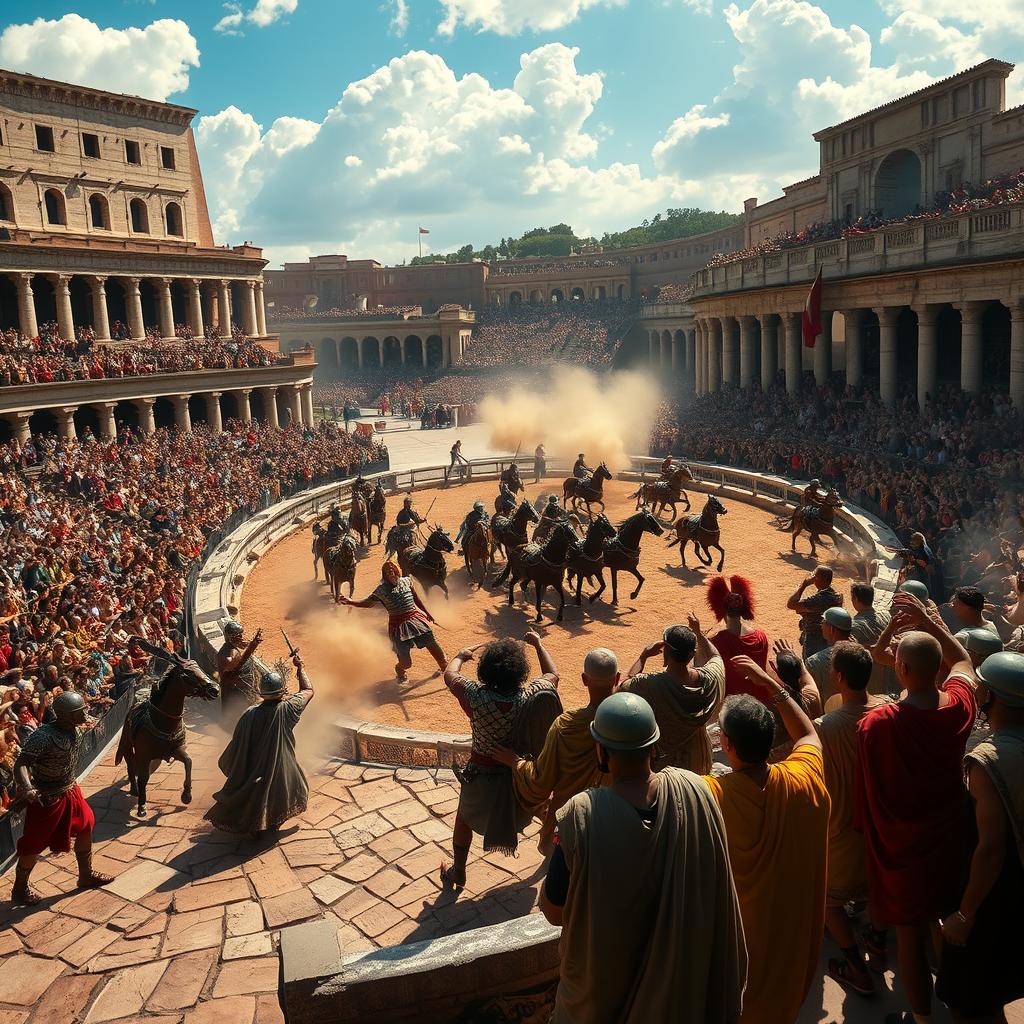
Gladiatorial Combat: When Entertainment Had Life-or-Death Stakes
The Colosseum stands today as a monument to Rome’s most notorious form of entertainment. But to truly understand the gladiatorial experience is to recognize how pale our modern entertainments appear in comparison. Unlike the scripted violence of today’s action films, gladiatorial combat offered genuine, unpredictable human drama with real consequences.
Imagine the sensory assault of the Colosseum during the games. The smell of sweat, blood, and exotic animals from distant lands. The sound of steel clashing against shields, the roar of beasts, and the thunderous reactions of 50,000 spectators – all unified in a shared emotional experience. You weren’t just watching the action; you were participating in it through your cheers, your judgment, and sometimes, your direct influence on the outcome.
What made this entertainment form so engaging wasn’t just the violence – it was the complete psychological experience. Gladiatorial combat tapped into fundamental human drives: our fascination with skill and courage, our desire for justice and mercy, our need for catharsis through witnessing struggle. Spectators formed intense emotional connections with favorite gladiators, following their careers and celebrating their victories. The psychological impact of seeing a beloved champion triumph – or fall – created emotional investments no streaming service could ever match.
While we passively consume scripted conflicts with predetermined outcomes, Romans participated in real human drama where the stakes couldn’t be higher and the outcomes remained uncertain until the final moment. The gladiatorial games weren’t just entertainment – they were a complex social ritual that reinforced Roman values of courage, discipline, and facing death with dignity.
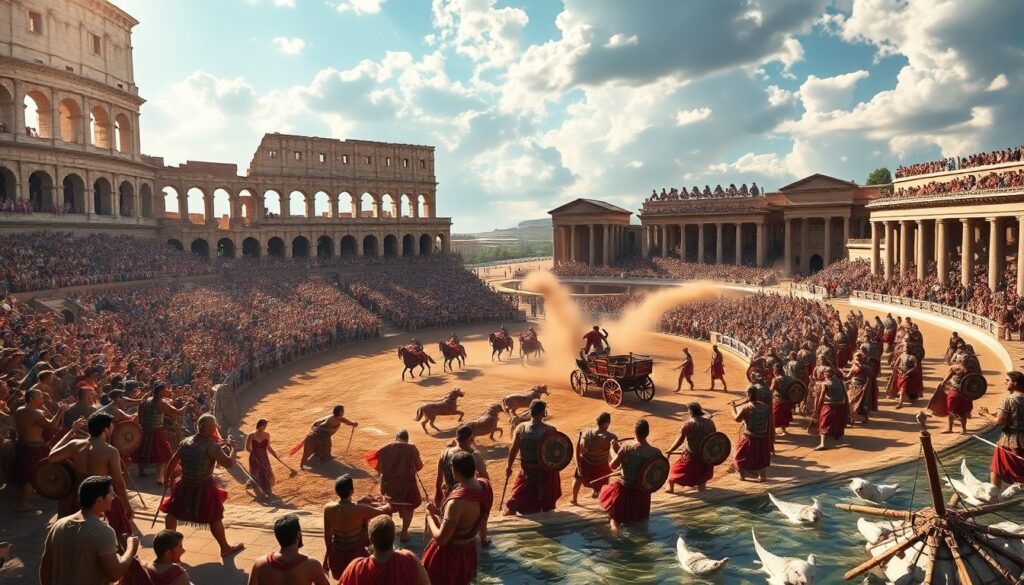
Chariot Racing: The High-Stakes Sport That United a Society
The Circus Maximus could hold up to 250,000 spectators – five times the capacity of the largest modern stadiums. Within this massive venue, Rome’s most popular sport unfolded with an intensity that makes modern motorsports seem tame by comparison. Chariot racing wasn’t just a sport; it was a societal obsession that transcended class, gender, and status.
The physical experience of attending the races would overwhelm modern sensibilities. The ground vibrated with the thunder of hooves and wheels. Clouds of dust filled the air, carrying the smell of sweat and effort. The collective gasp of a quarter-million people as chariots rounded the dangerous turning posts – the metae – created a wall of sound no surround system could replicate. This wasn’t passive entertainment; it was an assault on every sense.
What truly distinguished chariot racing was its deep integration into Roman society. The four racing factions – Blues, Greens, Reds, and Whites – functioned as social clubs, political entities, and identities more meaningful than many modern affiliations. Romans didn’t just watch their teams; they lived their success and failure with an intensity that modern sports fans can barely comprehend. Riots could erupt over racing outcomes – most famously the Nika riots of Constantinople that left tens of thousands dead and nearly toppled Emperor Justinian.
The economic ecosystem surrounding chariot racing would be familiar to modern sports fans, but operated on a scale that dwarfs today’s sports betting. Fortunes were won and lost. Successful charioteers became celebrities of unimaginable wealth and influence – the driver Diocles retired with winnings equivalent to billions in today’s currency. The racing calendar structured the Roman year, giving rhythm and meaning to public life in ways no streaming release schedule could hope to match.
While we might cheer alone on our couches for fictional characters in a scripted drama, Romans experienced the real, unpredictable drama of chariot racing as a unified community, their collective identity reinforced through shared triumph and heartbreak. No Netflix series could ever generate the authentic communal emotion of the Circus Maximus on race day.
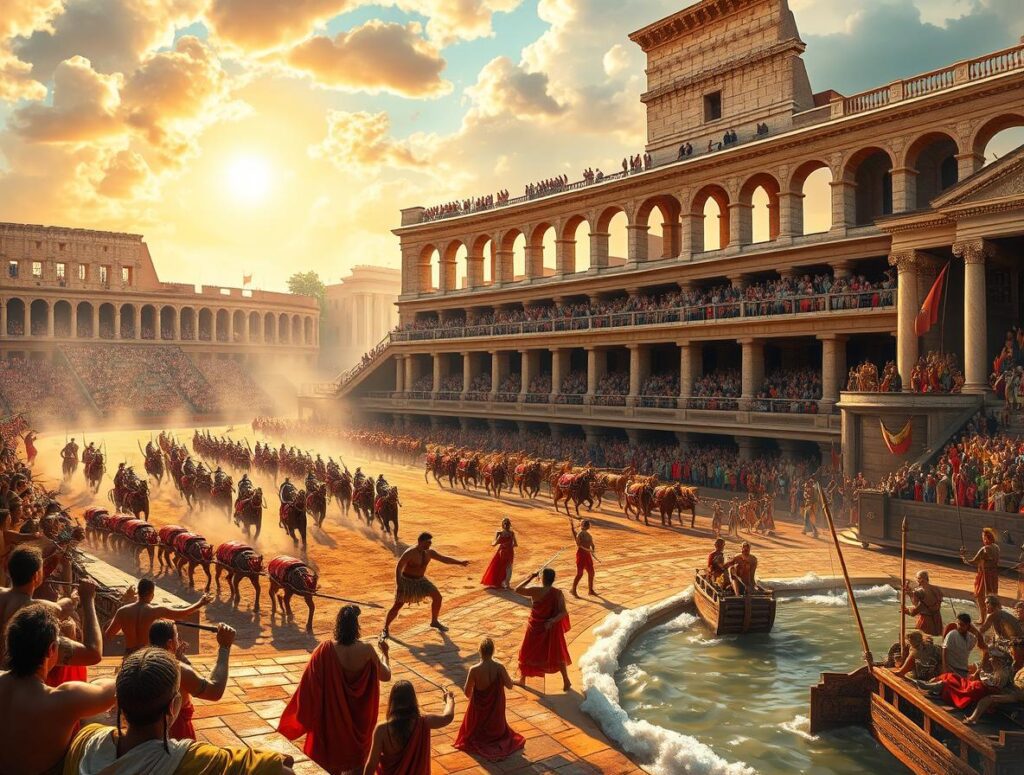
Theatrical Performances: When Theater Transcended Entertainment
Roman theater offers perhaps the most direct comparison to our modern entertainment consumption, yet even here, the differences are profound. While we stream pre-recorded performances from the isolation of our homes, Romans experienced theater as a living, breathing communal event that engaged all senses and reinforced their shared cultural identity.
The physical environment of Roman theater created an experience impossible to replicate digitally. Open-air theaters used sophisticated acoustic designs that allowed natural voice projection to reach thousands without amplification. The audience wasn’t separated from performers by a screen but existed in the same physical space, breathing the same air, feeling the same weather conditions. The boundary between performer and spectator remained permeable in ways impossible in recorded media.
Roman theatrical traditions encompassed a remarkable range: sophisticated comedies of manners, biting political satire, mythological tragedies, and ribald farces. But perhaps most distinctive were the mimes and pantomimes – performances that combined elements of dance, acrobatics, music, and narrative in ways that would seem startlingly modern. These performances often addressed contemporary issues with a frankness and physicality that would shock modern audiences accustomed to more sanitized entertainment.
Theatrical performances in Rome weren’t just entertainment – they were cultural touchstones that reinforced shared values and addressed societal tensions. Attending the theater wasn’t a passive experience but a civic activity that strengthened community bonds. Performances often coincided with religious festivals, embedding entertainment within larger spiritual and social contexts that gave it deeper meaning and resonance.
While we might binge an entire season of a show without speaking to another human being, Romans experienced theater as a fundamentally social activity – discussing performances, debating meanings, and forming collective judgments about artistic merit. Their entertainment wasn’t consumed in isolation but experienced together in ways that strengthened their sense of shared identity and values.
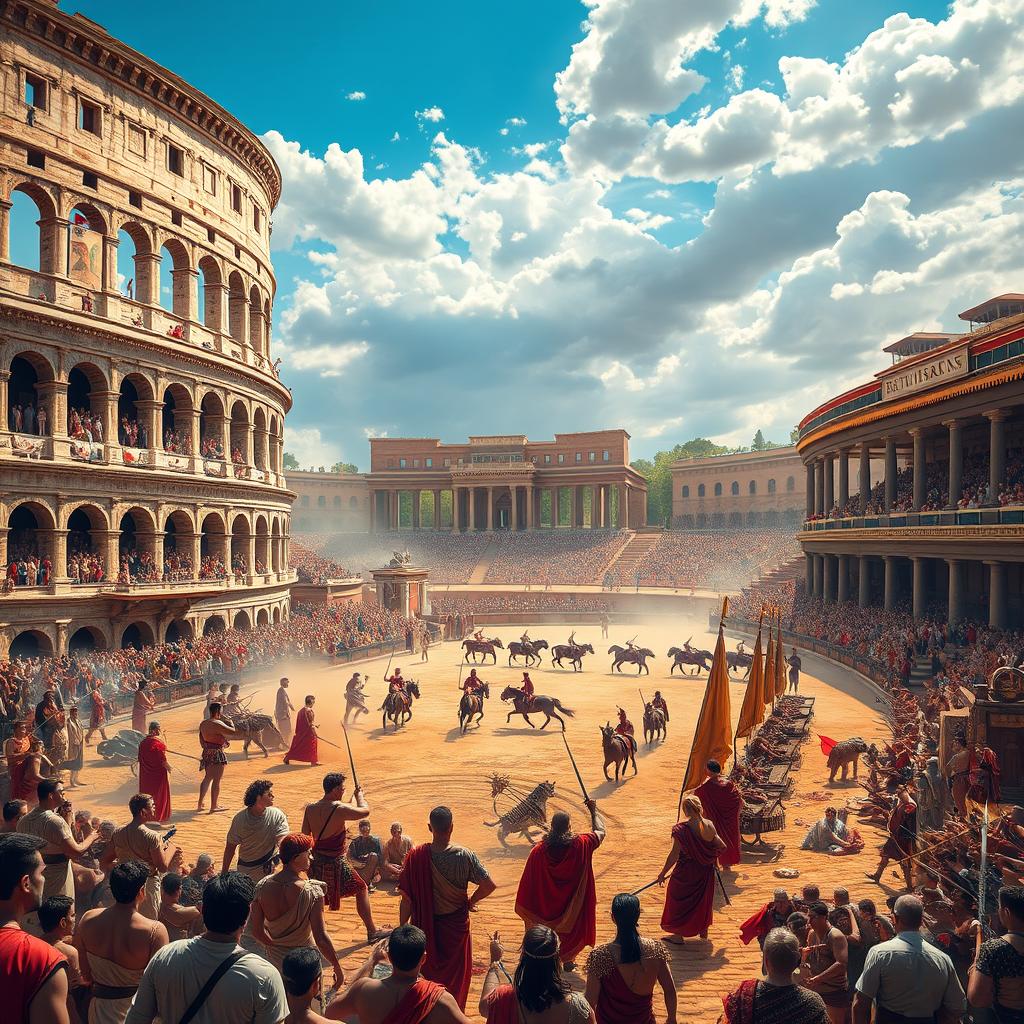
Public Baths: Where Leisure and Social Networking Converged
The Roman baths represent perhaps the most striking contrast to our modern entertainment patterns. While we retreat into private digital cocoons, Romans sought entertainment through deeply social, multisensory experiences that nourished body, mind, and social connections simultaneously. The baths weren’t just about cleanliness – they were comprehensive leisure centers that integrated physical wellness, intellectual stimulation, and social engagement.
Imagine entering the massive Baths of Caracalla, where the sensory experience would overwhelm modern sensibilities: the echoing sounds of conversation and splashing water, the contrasting temperatures of different bathing rooms, the scents of oils and perfumes, the visual splendor of marble, mosaics, and statuary. This wasn’t passive entertainment but a fully embodied experience engaging every sense simultaneously.
The architectural sophistication of Roman baths created varied environments for different activities and social interactions. The sequence of bathing – moving from the warm tepidarium to the hot caldarium and finally to the cold plunge of the frigidarium – provided a physical journey that modern spas still emulate. But the baths offered much more: exercise courts, reading rooms, lecture halls, gardens, and dining areas created a comprehensive leisure experience under one roof.
What truly distinguished the baths as entertainment was their function as social hubs. Romans of different classes mingled in relative equality, creating networking opportunities impossible elsewhere in their stratified society. Business was conducted, political alliances formed, and social connections maintained through regular bathing. Information and ideas circulated through these spaces, making them centers of intellectual exchange as much as physical relaxation.
While we scroll through social media feeds alone, Romans engaged in actual social interaction – debating ideas, sharing news, making connections – all within environments designed to stimulate both body and mind. The baths represented a holistic approach to leisure that integrated physical wellness, intellectual growth, and social connection in ways our compartmentalized digital entertainments cannot match.
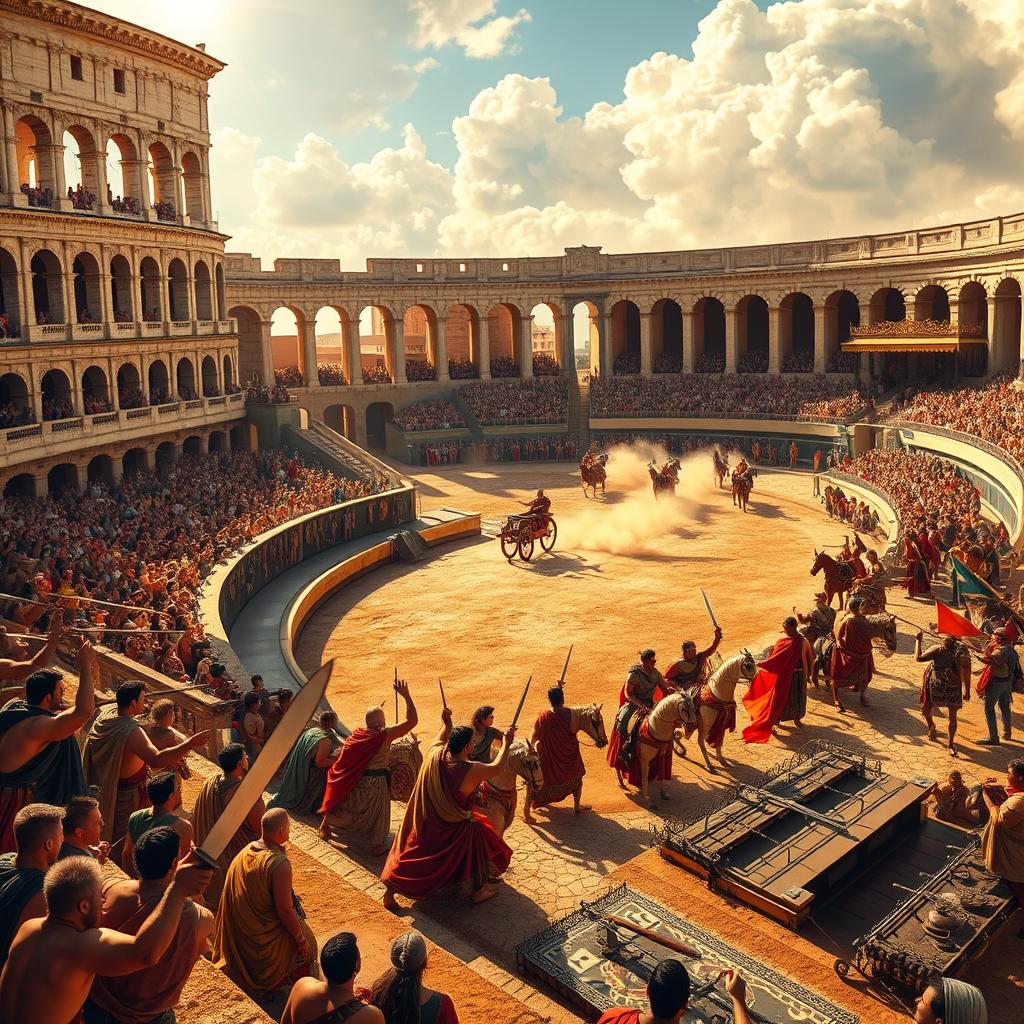
Religious Festivals: When Entertainment and Meaning Intertwined
The Roman religious calendar included over 200 festival days annually – more than half the year devoted to celebrations that combined entertainment with spiritual meaning. Unlike our secular streaming services that offer distraction without deeper significance, Roman festivals integrated entertainment into frameworks of meaning that reinforced community bonds and cultural identity.
The sensory experience of Roman festivals would overwhelm modern sensibilities. Streets filled with processions featuring music, costumes, and sacred objects. The aroma of sacrificial offerings and festival foods filled the air. Public spaces transformed through decorations and temporary structures. Participants didn’t just watch these spectacles but actively engaged through ritual actions, communal meals, and shared emotional experiences.
These festivals weren’t just entertaining diversions but expressions of core cultural values and beliefs. The Saturnalia – with its role reversals, gift-giving, and temporary suspension of social hierarchy – provided emotional release while ultimately reinforcing the social order. The Lupercalia’s fertility rituals addressed fundamental human concerns about reproduction and continuity. Even the most spectacular entertainments remained connected to deeper meanings about cosmic order and Rome’s place within it.
What made these festivals so compelling was their ability to combine entertainment with genuine community building. Unlike our isolated consumption of digital content, festival participation strengthened bonds between citizens while connecting them to their shared past and collective future. These weren’t just entertaining moments but formative experiences that shaped identity and reinforced social cohesion.
While we might discuss the latest streaming series in online forums, Romans experienced their entertainment collectively, their shared participation creating bonds of meaning impossible to replicate through screens. Their festivals weren’t just diversions from reality but expressions of reality’s deeper structures and meanings – entertainment that nourished rather than merely distracted.
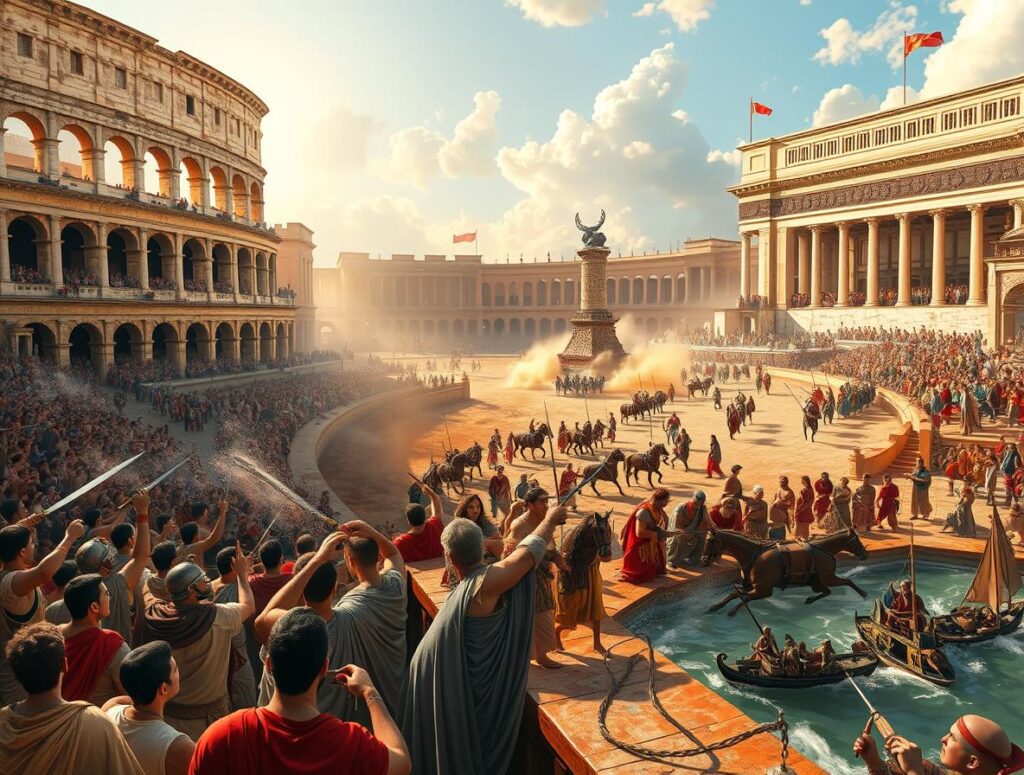
Naumachia: The Ultimate Spectacle of Naval Warfare
Perhaps no Roman entertainment form better illustrates the gulf between ancient and modern spectacle than the naumachia – staged naval battles that represented the absolute pinnacle of Roman entertainment ambition and scale. While we might be impressed by CGI naval battles on our screens, Romans created actual lakes, filled them with ships, and staged real combat with thousands of participants.
The sensory impact of these spectacles staggers the imagination. The first recorded naumachia, staged by Julius Caesar in 46 BCE, involved digging an artificial lake in the Campus Martius and filling it with actual warships manned by thousands of combatants. Later emperors expanded this concept to ever more spectacular scales. Augustus created a permanent naumachia basin measuring 1,800 by 1,200 feet, supplied by its own aqueduct. Claudius used the Fucine Lake, employing 19,000 combatants on fully equipped triremes in a battle watched by hundreds of thousands.
The psychological impact of witnessing such spectacles – the sounds of combat, the sight of ships maneuvering and colliding, the unpredictable outcomes as men fought with real weapons – created an intensity of experience impossible to replicate through any screen. These weren’t actors playing roles but actual combatants (typically prisoners of war or condemned criminals) facing genuine peril for the entertainment of spectators.
What made the naumachia so compelling wasn’t just its scale but its representation of Roman power and technical mastery. These spectacles demonstrated Rome’s ability to reshape environments, command vast resources, and recreate its naval victories for public consumption. They weren’t just entertainment but expressions of imperial might that reinforced Rome’s dominance and technical superiority.
While we might be momentarily impressed by special effects in maritime adventure films, Romans witnessed the actual spectacle of naval warfare – recreated at enormous expense purely for their entertainment. No digital experience, no matter how sophisticated, can match the visceral impact of seeing actual ships engaged in combat within a venue created specifically for spectacular display.
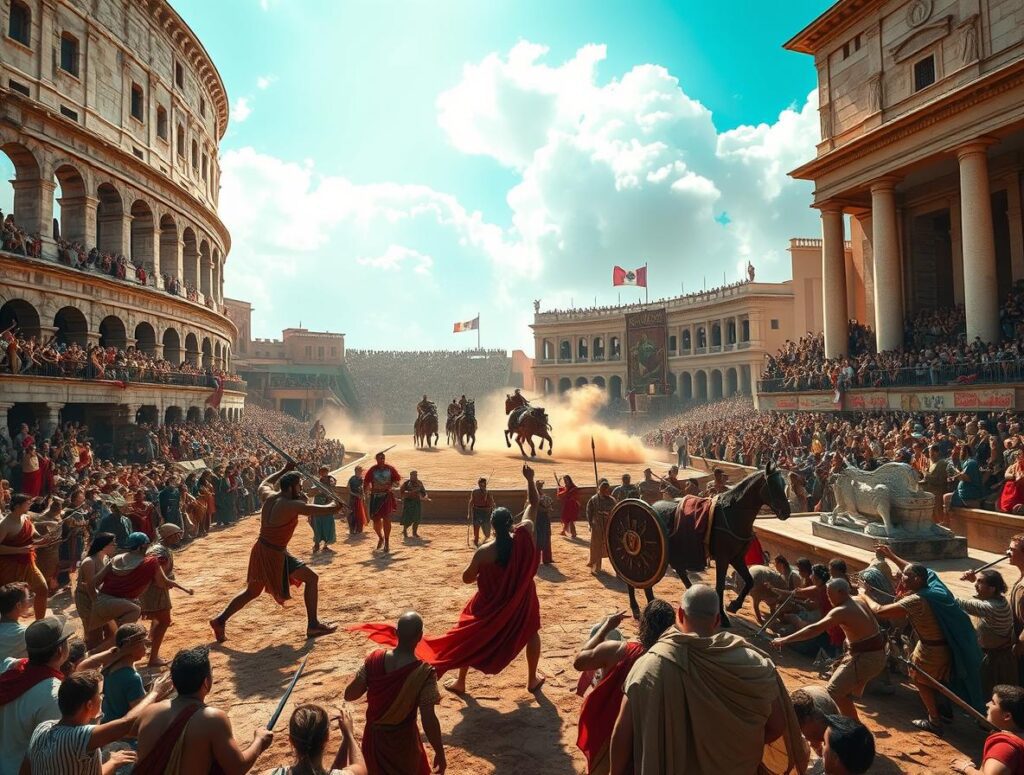
What Romans Understood About Entertainment That We’ve Forgotten
The striking contrast between Roman entertainment traditions and our modern digital diversions reveals fundamental truths about human psychology and satisfaction that we’ve lost in our screen-mediated world. The Romans instinctively understood principles about engagement and fulfillment that neuroscience is only now rediscovering.
Romans recognized that truly satisfying entertainment engages all senses simultaneously. Their spectacles weren’t just visual but multisensory experiences – the sounds of the crowd, the smells of the arena, the physical sensations of sitting among thousands of fellow spectators. By contrast, our digital entertainment engages primarily sight and sound while leaving other senses unstimulated, creating experiences that feel incomplete at a neurological level.
More importantly, Romans understood the irreplaceable value of shared experience. Their entertainment wasn’t consumed privately but experienced collectively, creating emotional resonance impossible to achieve in isolation. The shared gasp of the crowd, the collective tension during a chariot race’s final lap, the communal judgment of a gladiator’s performance – these created bonds of shared meaning that strengthened social fabric while intensifying the entertainment experience itself.
Perhaps most significantly, Romans recognized that entertainment gains power when it connects to deeper values and meanings. Their spectacles weren’t mere diversions but expressions of cultural identity that reinforced their understanding of the world and their place within it. Even their most violent entertainments reflected and reinforced values of courage, skill, and dignity in the face of death that gave their society coherence and purpose.
As we retreat further into algorithmic entertainment bubbles, perhaps we should consider what the Romans understood intuitively: that truly satisfying entertainment isn’t about passive consumption but active engagement, not isolation but connection, not distraction from meaning but expression of it. Our digital conveniences offer unprecedented access to content, but at the cost of the embodied, communal experiences that once made entertainment truly fulfilling.
The next time you settle in for a night of streaming, consider what the Romans would think of our solitary entertainment habits. They might pity us – not for lacking their spectacular resources, but for having forgotten that true entertainment happens not through screens but through shared experiences that engage our full humanity. Perhaps there’s wisdom in their ancient approach to leisure that our digital age desperately needs to rediscover.

